Ephemera and Eccentricities
Tradition and a 40th Anniversary Spice Up Tucson Meet Yourself, October 11-13
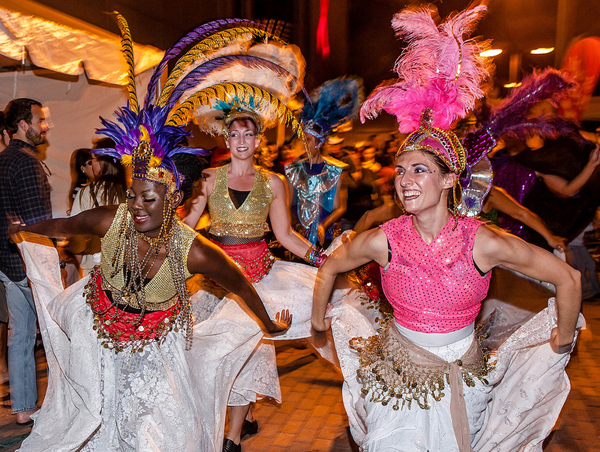
Celebrations of Tucson’s ethnic cultures are the reason for Tucson Meet Yourself!
photo: Steven Meckler/courtesy Tucson Meet Yourself
Tuck in your sari; swallow that mouthful of paella and hang on to your delicate Ukrainian egg. Somewhere between the first spring roll and listening to the bagpipes – you’ll be swept away by an annual phenomenon that lies dormant in Tucson until the second weekend of October. But then, ethnic pride blooms into quite a feast, a meeting of yourself Downtown, a delicious celebration that mixes up shared cultures in the desert.
Authenticity is serious business at Tucson Meet Yourself (TMY), celebrating its 40th anniversary this year. So is the eating and learning about what is both exciting and everyday in a most remarkable cultural stew.
The giant of a man behind all this is hard to miss! Although now leaning on a walker or riding his scooter, Dr. Jim Griffith, practicing urban anthropologist, still looms large at the annual festival. Plucking his banjo, admiring a Mexican lady’s flowers, listening to and talking with Tohono O’odham and Turks and everyone else in between, this man of everyday people has made sharing the multi-cultures of the Arizona-Sonora region his life’s work, resulting in books, the past directorship of the Southwest Folklore Center at the University of Arizona, as well as the nation’s highest honor for folklorists from the National Endowment for the Arts.
Veterans of Big Jim will not be disappointed this year when his showcase of ourselves again covers every corner of the Presidio, Jácome Plaza and environs – a site selected 40 years ago as “neutral ground” for the city’s cultural collaboration. Like an old-fashioned, massive quilting circle, TMY activates Downtown as its own utopian community, a funky melting pot along the lines of what Big Jim and Loma Griffith, the founders of TMY, call “the fruitcake model” – full of textures and colors that stand on their own within a nutty cake.
Doing the 40th
Even if you’re not a fruitcake fan you’ll still enjoy this party of the people. The 2013 event has some new elements, including:
The 40th Anniversary Cultural Kitchen foodway includes 25 food demonstrations from local cooking gurus, ranging from Ethiopian red lentil stew, to chiltepin chocolate ice cream and Swedish spritz cookies. Also expect prickly pear cheese cake, cholla bud/nopalito salad, Congolese lenga lenga (amaranth stew) and Russian beet vinaigrette salad. The kitchen runs until 7pm Saturday and all day Sunday, and of course the 50+ food booths are open until festival lights out.
The Lowrider Show and Shine returns to its original TMY location (Tucson Museum of Art), while nearby at La Cocina Old Town Artisans – there’ll be a satellite storytelling stage hosted by Pima County Library Foundation.
A new visual and educational exhibit on the Chinese in Tucson will be sponsored by the Chinese Cultural Center in a tent outside the main library at Jácome Plaza, while the Western History Association (conducting its annual meeting up in the Foothills) will host a panel discussion on one TMY stage, bringing scholars who study the history of the west Downtown to join the festival fusion.
Expect the 25th Annual AIDSWalk Tucson to traverse through the festival, kicking off Sunday’s program, beginning at 9am.
Tall Tales
While for many TMY is all about the food, others are interested in the peculiar folklore that has grown up around the festival over four decades. If you haven’t heard the storytelling, here are a few tales:
- Setting for miracles: The worst tropical storm in Arizona’s history occurred in 1983, with this 100-year flood reporting the highest crests in the Rillito and the Santa Cruz. Campbell Avenue was a river and Grant Road a lake, and distraught festival planners worked out contingency plans with the city and Pima County, so that the cultural clubs who relied on TMY food sales wouldn’t be devastated by the downpours. As it turned out, that year the rains abruptly ceased the Friday of the festival, opening a circle of blue sky over TMY Friday through Sunday – whereupon the rains began again all over Tucson. Or so the folklore goes.
- The Name Game: The first “Tucson, Meet Yourself” (an intentional comma provided a grammatically correct invitation) was a two-day affair, kicked off by a Friday night “Fandango” (animated dance party) at a newly built La Placita Village. In 1975, the name changed to “TMY and Friends,” to allow all the ethnic you’d ever want from other parts of the country to join in the Tucson party. That year, TMY hosted national recording artist and first lady of Tejano Lydia Mendoza, among other national artists. The name returned to “Tucson Meet Yourself”(without the comma) in 1976, and that name stuck (except for a 1995-2000 hiatus, when the festival was called “THE Tucson Heritage Experience,” and not run by Jim and Loma).
- Experimentation: Although the mission remained the same over 40 years, Jim often looked for ways to keep the festival fresh. Some ideas, like the Liar’s Contest, which had as its top prize a bronzed cow pie on a plaque, came in 1979 and stayed for a few years. Others, like the corrido contest, begun in 1982, remain an important part of the festival.
- Supper breaks: In the early years, TMY employed a very-extended supper break on Saturdays to allow tradition bearers to eat and refresh before the evening program. Back in 1974, the festival needed a way to let folks know the festival was starting up again after the supper break. Someone suggested that the pipers process from their courtyard practice area to the city hall stage, bellowing away to herald the program restart. The tradition stuck (even after supper breaks ended in the mid-1990s).
- Paseo: In the 1980s, when one group wanted to do a fashion show onstage, Jim and team responded by asking all groups to participate in a traditional Show and Tell called the Paseo. For many years, promenades of ethnic costumes were the de rigueur of the Saturday programs. Women and men wearing traditional and contemporary styles of dress proudly displayed their outfits while an emcee explained the intricacies as well as the meaning of the colors and the ornamentation. The Paseo continued off and on but in a minimal way after the formal supper breaks ended.
- Gang of Five: What started as a gathering put together by Jim and Loma’s close friends evolved even in the early years as a complex undertaking requiring hundreds of volunteers. The beginning core volunteer group was called the Gang of Five (a nod to the Mao Zedong era and his revolutionary political group known as the Gang of Four). The Tucson gang that planned and ran the festival from the late 1970s until 1995 actually never numbered five. Started after strong urgings from Loma, the group always numbered somewhere between four and 15. Mike and Frieda Stafford, who met doing garbage detail at the festival, and celebrated their honeymoon hauling a white garbage cart through the park with “Just Married” written on it, were part of the early Gang of Five. They’re still married and still attend TMY.
Inevitably, as you lick the last remnants of fry bread from your fingers, someone asks a question about the origins of the treat, or how to spell how to spell chivichanga. And that leads to an exchange at the heart of Jim and Loma’s festival vision: The more we appreciate, the more we’ll respect, increasing the chances of understanding and working together.
The generosity of simple people allowing strangers into their cultures for 40 years is something to remember as we eat or dance or touch that priceless traditional artwork. After the TMY blitz of culture overload that hits the sweet spot this month, ordinary life will seem that much more extraordinary to you.
The free festivities take place at the main library plaza, El Presidio Park, and surrounding streets from 11 a.m.-10 p.m., Oct 11-12 and 11 a.m.-6 p.m., Oct 13. Schedule and parking information is available at TucsonMeetYourself.org.
________________________________________________________________________________________
TMY Time Capsule
If you want a head start (or a follow up) to the festival, be sure to visit Special Collections, UA Main Library, where a rich repository of TMY folklore is on display, in an exhibit that crisscrosses culture with historical documents and enough visual ephemera to call up festival fun.
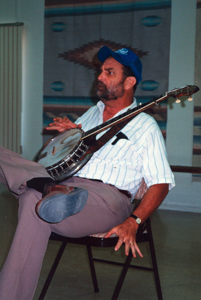
“Big Jim” Griffith with his banjo, likely sharing a story before playing a song.
photo courtesy TMY/date unknown
This time capsule of posters, t-shirts, music, leaflets, tickets, albums and all sorts of Big Jim memorabilia was assembled by UA associate librarian Bob Diaz (who also is Library coordinator of exhibits and events and curator of the Library’s Performing Arts collection).
The exhibit is organized by eras and themes, which unfold into unique TMY snapshots, past and present. Each display case, panel or kiosk feels like its own treasure chest, worthy of pleasurable browsing. Adding to the complexity and fun is a music kiosk, containing audio from the festival’s early years. Another large monitor gives great pictorial punch and, sometimes, emotion, to the exhibit via a photographic faces of the festival display.
The overall history itself comes alive through material that tells a different side of the well-known story: for example, there are Jim’s 1974 handwritten and typed notes that show ideas and budget for the 1974 event. In another case, the first corrido contest is brought to life by its printed ephemera. Dog eared old photos provide a connection with the past in ways that today’s digital images cannot – illuminating TMY history to new generations.
An hour before what turned out to be a packed opening-night reception in mid-September, Big Jim and Loma were seen surveying the cases with apparent delight. All told, the exhibition presents hundreds of items from a collection Jim donated to the archives several years ago. Fascinating and even a little weird (the bronzed Liar’s Contest cow pie plaque is on display), this Big Jim exhibition is worth a trip.
“40 Years of Tucson Meet Yourself” is on view at Special Collections, UA Main Library, 1510 E. University Blvd., through January 12, 2014. Hours are Monday-Friday, 9 a.m. to 5 p.m. Entry is free, as is use of the vast and interesting Special Collections archives, where anyone is allowed to research priceless documents and memorabilia on subjects as varied as mining, Gabrielle Giffords or Stewart Udall archives, and an oddly wonderful vaudeville collection. All that is required is to complete some paperwork. A professional band of archivists and librarians are always available to help you discover something interesting about the Southwest. Learn more at: SpecColl.Library.Arizona.edu.


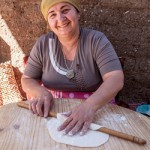
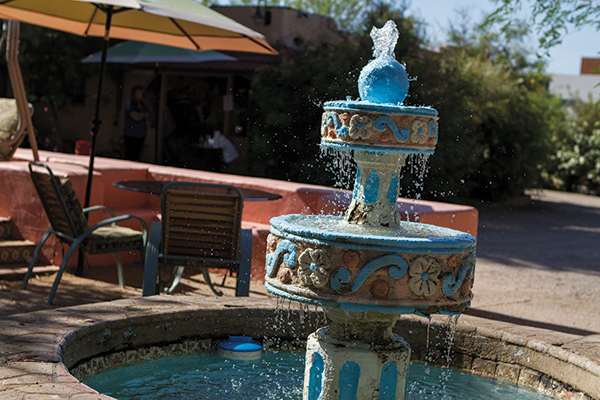
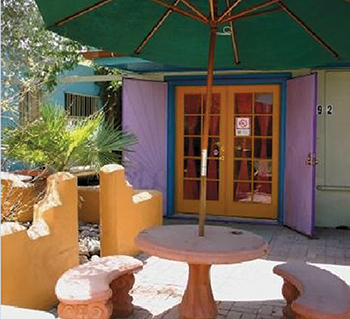
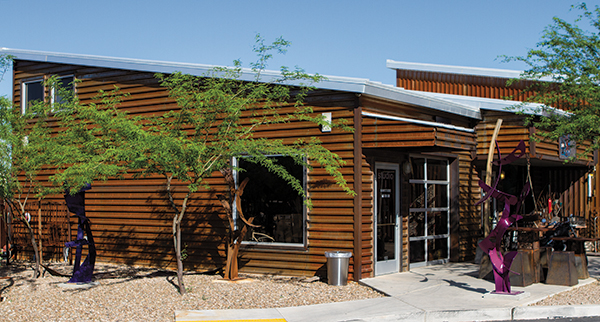
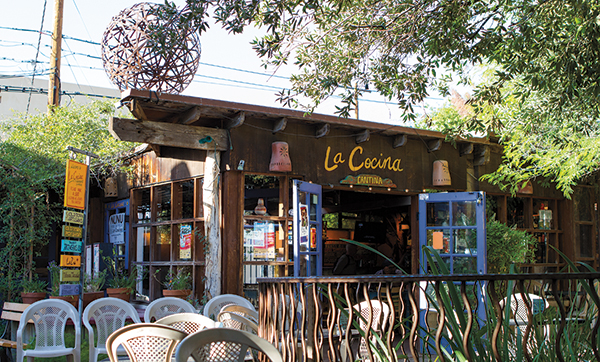
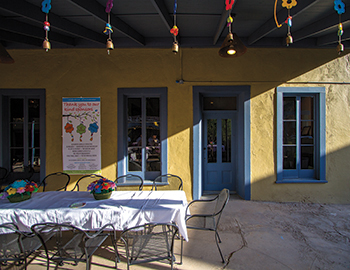
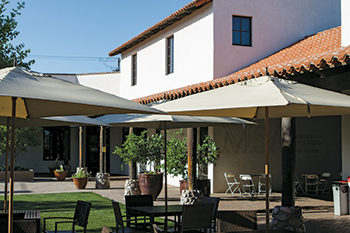
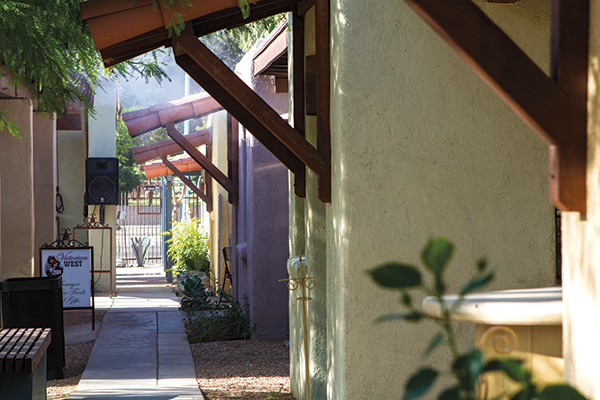
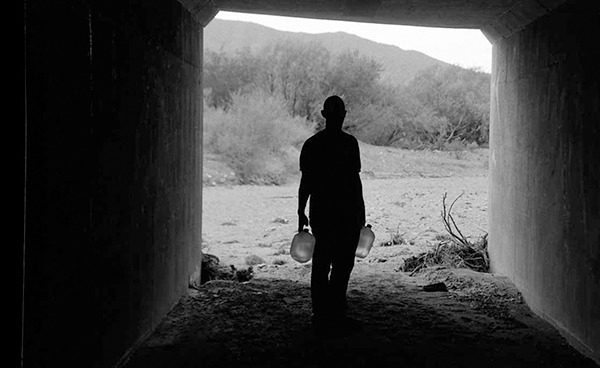

 Prepare to meet, eat and dance yourself silly
Prepare to meet, eat and dance yourself silly


 Tradition & Tejaño, Folk & Fest
Tradition & Tejaño, Folk & Fest In addition, Tucsonans wanting to learn more about the history and the variety of waila styles should visit Himdag Ki:, the Tohono O’odham Nation’s Cultural Center and Museum located in Topawa, just south of Sells. The “Tohono Kaidalig: Tohono O’odham Piast Ñe’ñei” exhibit opens this month, featuring a rich selection of historical waila photos and multi-media. The exhibition is accompanied by a re-creation of old-time waila stage as well as instrument displays and recordings. There’s an opening reception on September 13 with traditional foods and live waila performances. The Cultural Center and Museum also will bring together local musicians in a waila series to be scheduled in conjunction with the exhibit, which will run for about six months.
In addition, Tucsonans wanting to learn more about the history and the variety of waila styles should visit Himdag Ki:, the Tohono O’odham Nation’s Cultural Center and Museum located in Topawa, just south of Sells. The “Tohono Kaidalig: Tohono O’odham Piast Ñe’ñei” exhibit opens this month, featuring a rich selection of historical waila photos and multi-media. The exhibition is accompanied by a re-creation of old-time waila stage as well as instrument displays and recordings. There’s an opening reception on September 13 with traditional foods and live waila performances. The Cultural Center and Museum also will bring together local musicians in a waila series to be scheduled in conjunction with the exhibit, which will run for about six months.



Also find us on...